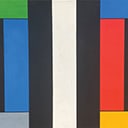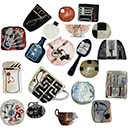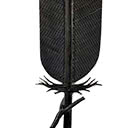Feather
189.2 x 29 cm
est. $60,000 - 80,000
In June 2010 a single huia tail feather sold at auction in Auckland for NZ$8,000 - making it the world's most expensive feather. Always treasured, the feathers were once traded widely and stored in waka huia, but they are now extremely rare outside of museum collections. Maori regarded the bird as tapu, and wearing its feathers was reserved for people of high status. A fashion craze started amongst Europeans in 1901 when photographs circulated of the visiting Duke of York wearing the feather he had been given by a guide in Rotorua in his hat band. As a result, the birds had been hunted to extinction by 1907.
Born in Thames, Paul Dibble was raised on a farm at Waitakaruru and studied sculpture at the Elam School of Fine Arts, graduating with a Dip.F.A. (Hons) in 1967. He taught painting and sculpture in Palmerston North from 1977, establishing his own bronze foundry there in 2000. He was made a Member of the New Zealand Order of Merit in 2005 for services to sculpture, and his work is held in the collections of the Museum of New Zealand Te Papa Tongarewa, the Dowse Art Museum, Te Manawa in Palmerston North and the Christchurch Art Gallery.
Paul Dibble's Feather sculpture is a tribute to the memory of this remarkable bird with its 12 distinctively-striped tail feathers. His scaled-up huia feather stands vertically like a monument, propped up by a forked stick like a crutch, and is a reminder of the frailty of all indigenous avifauna where their habitats are threatened by introduced predators.





